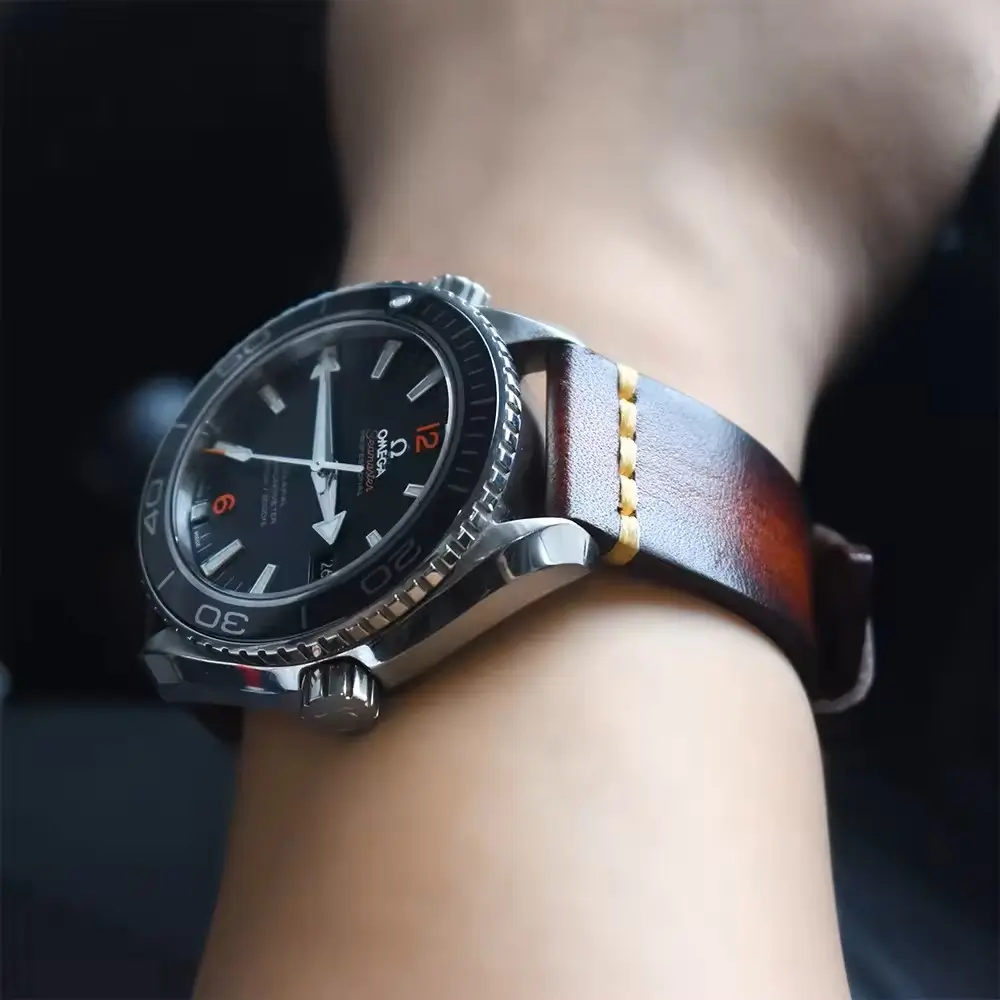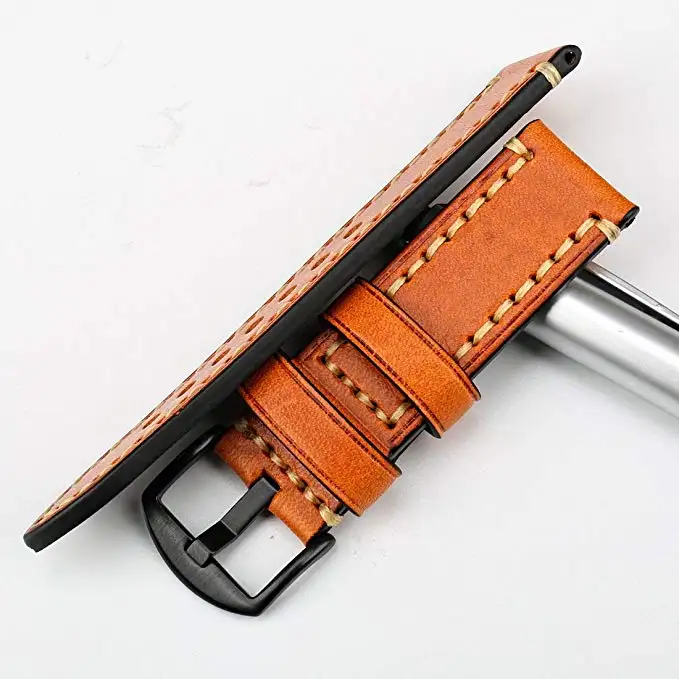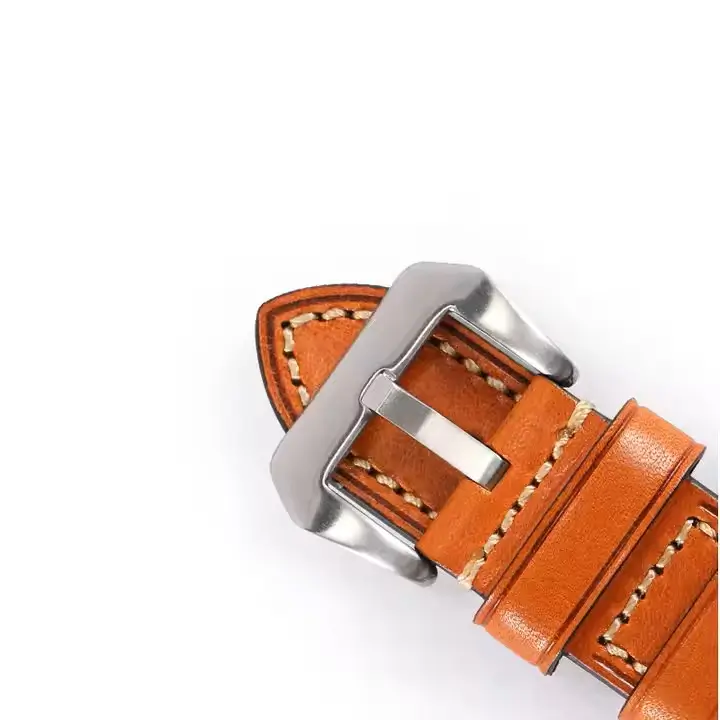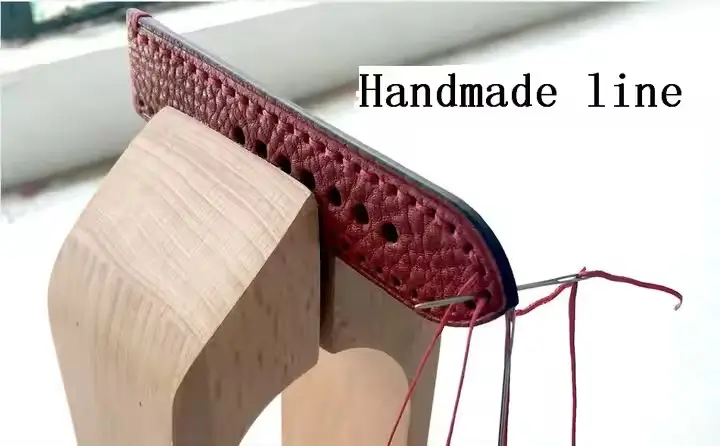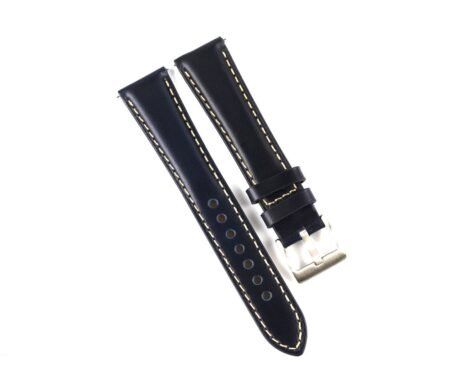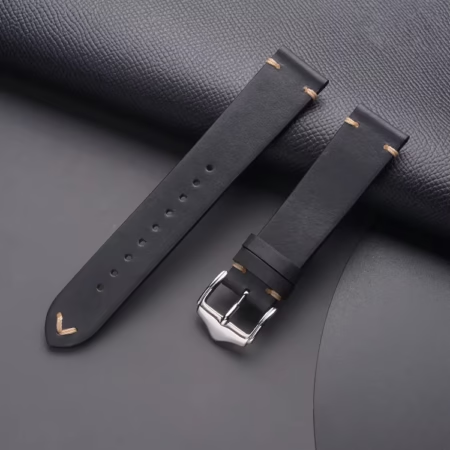Ultimate Guide to Leather Watch Straps: Essential Tips, and Key Concepts.
Why Should You Buy A Leather Watch Strap?
Staying on top of the latest fashion trends and finding the perfect accessories is key, especially when it comes to luxury watches. A watch is more than just a timepiece. It’s a statement, a reflection of your style, and often the first thing people notice about your outfit. It’s a well-known fact that for many watch enthusiasts, a luxury watch isn’t just an accessory; it’s an investment, a symbol of craftsmanship and elegance. But even the most exquisite watch can be elevated further with the right strap.
While there are various materials available for watch straps, however leather stands out as the top choice for those who value both style and durability. A well-crafted leather watch strap not only adds a touch of sophistication but also gently complements your overall look, and can be perfectly matched with belts, shoes, ties, handbags, and outfits. Whether you’re dressing up for a formal event or adding a touch of class to your everyday attire, a high-quality leather strap enhances the look of your luxury watch, making it a timeless accessory that speaks volumes about your taste.
9 Essential Tips to Know Before Buying Leather Watch Straps
Choosing the perfect leather watch strap can elevate your timepiece, but there are key factors to consider before making a purchase. From the type of leather and stitching quality to sizing and buckle style, each element plays a crucial role in both the look and durability of your strap. Understanding these details ensures you invest in a strap that not only complements your luxury watch but also enhances your overall style. Dive into our guide to discover the 9 essential tips that will help you select the perfect leather watch strap for your needs.
(1) Understanding the Various Types and Sources of Leather for Watch Straps
Although exact figures are hard to pin down, research indicates that the leather industry is predominantly driven by cattle, which accounts for 65% of all leather. Sheep contribute around 13%, goats about 11%, pigs 10%, with the remainder coming from other and exotic animal skins. Each type of leather has unique properties that make it suitable for specific products—some are perfect for shoes, others for bags, and some for smaller accessories such as wallets and watch straps.
When it comes to watch straps, the type of leather used can significantly impact quality, durability, and appearance. By understanding the different sources of leather, you’ll be better equipped to assess the quality and authenticity of a seller’s offerings, ensuring you make an informed choice that suits your style and provides peace of mind.
When selecting a leather watch strap for your luxury timepiece, it’s essential to consider the type of leather that best suits your lifestyle and aesthetic preferences. Whether you opt for the timeless elegance of full-grain leather or the exotic appeal of alligator leather, a high-quality strap will enhance your watch and ensure it remains an awesome accessory for years to come.
What are the Sources of Leather?
Buffalo Leather
Buffalo leather is thicker and sturdier than cowhide, making it ideal for larger bags like duffels, backpacks, and totes. It has more prominent grains and feels thicker when you touch it.
Calf Leather (Calfskin)
Calfskin, being softer and lighter than cowhide, has finer grains and is more flexible. It’s often used in high-quality watch straps, offering durability and a smooth feel. Due to limited availability, calfskin is more expensive than other leather types.
Cowhide Leather
Cowhide leather is widely used in garments, bags, wallets, belts, and watch straps. It’s thinner and more flexible than buffalo leather but still durable. Cowhide watch straps develop a patina over time.
Sheep and Goat Leather
Both goat and sheep leathers are soft and lightweight with fine grains. Though not as strong as cow or buffalo leather, they are prized for their softness, making them popular for watch straps and other leather accessories.
Kangaroo Leather
Kangaroo leather is strong like cowhide but more flexible, similar to goat leather. It’s commonly used for boots, wallets, and watch straps, offering small cracked grains and a unique texture.
Horse Leather /Shell Cordovan Leather
Most of us are familiar with shell cordovan leather but have hardly heard about horse leather. Horse leather is shell cordovan leather known for its toughness, water resistance, and natural shine. Limited supply and Complex tanning process make it expensive. It has been used for top-end shoe making for a long time; however recently been introduced in watch straps making and other accessories like wallets and bags. Watch straps made out of shell cordovan are known for their strength, glossy finish, and natural feel; these are expensive compared to cowhide leather.
The best-selling colors in the shell cordovan are burgundy, whisky brown, and dark brown
The average price of a shell cordovan watch band is around $120
Exotic Leather
Exotic leather comes from reptiles like alligators, crocodiles, ostriches, stingrays, and snakes, often hunted primarily for their skin, though some types are protected under CITES (Convention on International Trade in Endangered Species). Among these, alligator leather stands out for its natural, distinctive scales, with the belly being the most prized section for crafting luxury items such as bags, wallets, watch straps, and shoes. Crocodile leather, often more recognized than alligator leather, is a favorite among top luxury brands due to its unique texture and rarity, making it one of the most expensive and sought-after exotic leathers on the market.
What are the Different Grades of Leather?
Mainly there are four grades of leather. The average cowhide thickness is 6 to 10 mm; this thickness is further cut into different layers. The first layer is called full-grain, 2nd one is called top grain, 3rd called split leather, which is the underside of the skin, and the fourth one is bonded or genuine leather, made from leather scrap.
Full-grain leather.
It’s thought to be the highest quality leather. As the name says, it has full grains intact to the leather. Being the least processed form of leather, it’s a shadow of the animal’s skin; other than removing hair, it carries all the imperfections, pores, and scars on the animal’s skin when it’s alive. These characteristics make this leather special and add ultimate beauty to the product. Full-grain leather lasts longer because of the strong fibres of the skin, and its breathability keeps it away from cracking. Since each animal’s skin is different, this grade of leather will differ on every second hide. Due to its breathability, it gets softer when used over time.
It’s more durable, carries high resistance, and develops a patina with time. It’s widely used in crafting top-quality leather accessories like briefcases, shoes, bags, and watch straps/bands. Full-Grain Leather Watch straps will be stiff at the start but soften as time passes.
Top Grain Leather.
It’s the 2nd best leather after full-grain leather; with the sanding and buffing process, its imperfections are removed from the skin, making it more uniform and smoother compared to full-grain leather. It’s suitable for printing textures and designs like Epsom, pebble, and nubuck. It’s slightly thinner than full grain and easy to work for artisans; moreover, it has a better resistance against stains because of the material coating at the top of the leather. It’s used in high to mid-range accessories and is easily available.
Split Leather.
It’s the last layer of the skin which is very close to the animal flesh and derived after splitting all the layers of the skin. Its most common type is Suede leather. Suede is the softest among all types of leather to make a watch strap. Its velvety look and smooth feel are attractive attributes for making shoes, bags, and other small accessories in addition to watch straps/bands. The downside of this leather is that it absorbs liquid quickly, making it less durable than other types of leather.
Bonded Leather.
It’s not 100% real leather; polyurethane binder is mixed up with leather scrap, dust, and fibres, and then the processed mixture is glued together with fabric or paper backing. It’s also called reconstituted leather as it only consists of 10 to 20% real leather, and the rest is polyurethane binder.
It’s used in cheap leather furniture upholstery and accessories like bags, wallets, watch straps, belts, etc.
It has a plastic feel, smells artificial, and has a flat surface.
Genuine Leather.
Genuine leather is the cheapest; some people consider it in the category of split leather, and some in bonded leather. However, it’s a widely used term for leather; it’s better to avoid this leather since it doesn’t describe well the grade of leather. Newbies take it as the opposite of fake leather, but it’s not. It could be artificial or low-grade leather. Once you spot a product with the stamp “genuine leather,” don’t trust it straight away. Carefully examine its surface if it’s very smooth and gives you a laminated feel; then try to bend it, if it comes back to the original position without leaving any wrinkles on the bent surface, then this is a clear sign of fake or artificial leather. Please stay away from it.
Ideally, it should be a split leather, but in most cases, it’s used as an alternative to bonded leather to confuse customers.
Products tagged as genuine leather are generally very cheap and don’t last long compared to the above-mentioned high-quality leather types.
(2) Understanding Leather Temper
When it comes to leather, temper refers to its pliability and softness. You can feel this quality the moment you hold a piece of leather in your hands, especially when you fold or bend it. This tactile experience is crucial when selecting a leather watch strap, as it can significantly influence your overall comfort and style.
There’s a range of softness and flexibility in leather straps. Some people prefer a semi-stiff feel for added support, while others lean towards a softer touch for maximum comfort. Interestingly, certain leather straps start getting soft, while others become more supple over time with wear.
So, whether you’re after a more structured look or a luxurious, soft feel, understanding leather temper will help you find the perfect watch strap that suits your style.
(3) Leather Strap Thickness
When selecting a leather watch strap, thickness is a crucial factor that affects both comfort and style. Generally, leather watch straps fall within the range of 3 mm to 4.5 mm in thickness, providing a lightweight feel while ensuring comfort on your wrist. However, the thickness can vary based on the strap’s width and style. For example, padded straps often ticker from one end (pin end) and thin from the other end while flat straps maintain a consistent thickness regardless of width.
Another important consideration is the strap length. If you opt for a thicker strap, it’s essential to choose a longer length to ensure it comfortably wraps around your wrist. For instance, if you’re going for a strap thicker than 4 mm, increasing the strap length by a couple of millimeters can help accommodate the added thickness.
Keep in mind that when you first wear a leather strap, it will feel tight and should hug your wrist closely. With regular wear, the leather will stretch and soften, providing a more comfortable fit over time.
What’s the best Watch Strap Thickness
There’s no definitive right or wrong when it comes to selecting the ideal watch strap thickness. It’s all about personal preference and the specific watch style. If you have a thicker wrist, a watch with a larger case and a broader band will create a balanced look. Conversely, if you have a slender wrist, a smaller watch with a thinner strap is often the best choice.
Dress watches are typically slimmer for a reason: they’re designed to slide effortlessly under a suit cuff. A thicker watch and strap may struggle to fit comfortably beneath formal wear, so consider this when making your choice.
Ultimately, understanding these variables will help you choose the perfect leather strap thickness, ensuring both style and comfort for your luxury timepiece.
(4)Hardware (Buckle and Pins) Quality
When investing in a watch band, it’s essential to consider the quality of the hardware, particularly the buckle and pins, as they play a significant role in both stability and aesthetics. High-quality hardware ensures your watch stays securely on your wrist while enhancing its overall beauty. A popular choice for premium watch hardware is 304 stainless steel, known for its exceptional durability and corrosion resistance, making it ideal for daily wear even in humid conditions. This material is tough enough to withstand impacts and scratches, hypoallergenic for sensitive skin, and boasts a sleek, polished finish that adds elegance to any watch strap. 304L stainless steel comes in various finishes and the selection depends upon your choice.
(5) Size Of The Leather Watch Straps
When it comes to selecting a perfect leather watch strap, knowing your lug and wrist sizes is crucial before you purchase. The lug size is usually indicated on the back of the strap or can be found through the watch manufacturer. If you don’t have that information handy, a simple ruler can help you measure it in millimeters (mm). For those with an average wrist size, opting for a standard-length strap is perfectly fine, as you don’t need to worry about extra long or short.
One great advantage of two-piece straps is their adjustability; they can be easily tightened when buckled, meaning it’s not a problem if the strap length is slightly longer than needed. By ensuring you have the right measurements, you can confidently choose a strap that suits your luxury watch. If you are not sure how to measure your wrist or band, check our comprehensive guide about sizing.
(6) Padded vs. Non-Padded Leather Watch Straps
In leather watch straps, one of the key decisions you’ll make is whether to go for padded or non-padded options. Padded leather watch straps feature a layer of padding stitched between two layers of leather to give them an elegant and luxurious appearance. The padding material can vary widely, ranging from cardboard and cotton wadding to neoprene foam, synthetic materials, or even leather itself.
The manufacturing processes and designs of these straps also differ. Some straps have a lining that is glued and stitched to the underside to provide extra comfort and durability, while others, especially vintage styles, are made from a single layer of leather to enhance their classic look. Common lining materials include sweat-absorbing leathers like Zermatt, suede, Epsom, or chèvre, each has its unique characteristics.
Ultimately, whether you choose a padded or non-padded strap depends on your personal style and comfort preferences. Both options can beautifully complement your luxury watch, so take your time to find the one that best fits your aesthetic.
(7) Leather Watch Straps Stitching
what makes a leather strap apart especially in looks? The answer is its stitching—a subtle yet crucial aspect that speaks volumes about craftsmanship, durability, and style.
Stitching isn’t just about holding a strap together; it’s a hallmark of quality. Expertly crafted stitching enhances your leather watch strap’s look, feel, and lifespan. It’s the fine line between a strap that complements your luxury timepiece and one that falls short. If you’ve ever wondered why some straps look more refined than others, the secret often lies in the stitching technique and the materials used.
The type of thread used in stitching can make a world of difference. Premium leather watch straps often use waxed linen or polyester thread. Waxed linen offers a natural and slightly rustic appeal, perfect for vintage-style watches. In contrast, polyester threads provide exceptional strength and resistance to the elements, making them ideal for everyday wear.
If you Look closely at your leather strap, and you’ll notice the stitch length, consistency, and placement. High-quality straps will feature even, tight stitches with no loose ends or fraying.
(8) Five Basic Rules to Match Your Leather Watch Straps
1. Match Your Outfit
Think of your leather watch strap as an extension of your outfit. Start by checking your other accessories, like your belt, shoes, or bag. Aim for the same strap color coordinates with other accessories, like black leather watch strap for black shoes and belts, and brown leather strap for brown. A slight variation in shade is fine, but keeping the main color consistent pulls everything together.
2. Consider the Dial Color
As we know, the dial is the face of your watch, and pairing it right can elevate your entire look. The most common dial colors are black, blue, silver, and white. For a perfect match, go for a black leather strap with a black dial or a blue strap with a blue dial. Brown or tan leather straps are your go-to for silver and white dials to give warm and classic look.
3. Align with Watch Hands and Markers
Pay attention to the details, like the color of the watch hands and markers. A subtle yet stylish trick is to match the stitching on your leather strap with these elements. For example, a strap with matching gold stitching adds a sophisticated touch if your watch has gold If markers. If you’re curious to explore the anatomy of a watch in greater detail, click here.
4. Reflect Your Wardrobe
Your watch strap should feel like a natural part of your wardrobe. If your closet leans towards specific colors, like greens or blues, consider matching your straps accordingly. A green leather strap could be the perfect standout piece that complements your style without overwhelming it.
5. Choose the Right Leather Finish
When it comes to leather finishes, it’s all about personal preference. Options range from smooth and shiny to bumpy, vintage, or distressed. Keep in mind some finishes, like Pebble and Epsom, offer added scratch resistance, making them perfect for daily wear. Choose a finish that not only suits your style but also your lifestyle.
